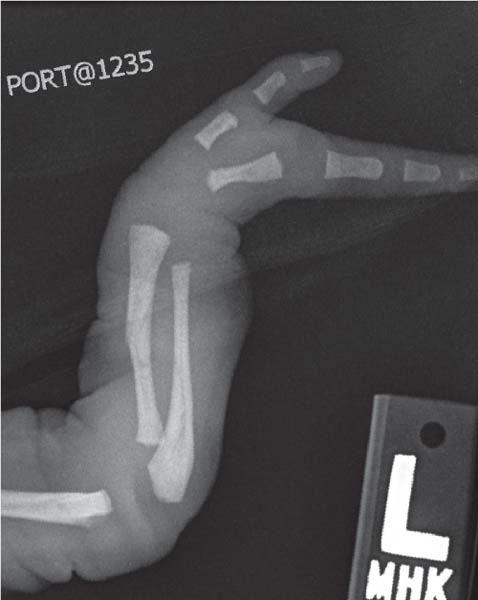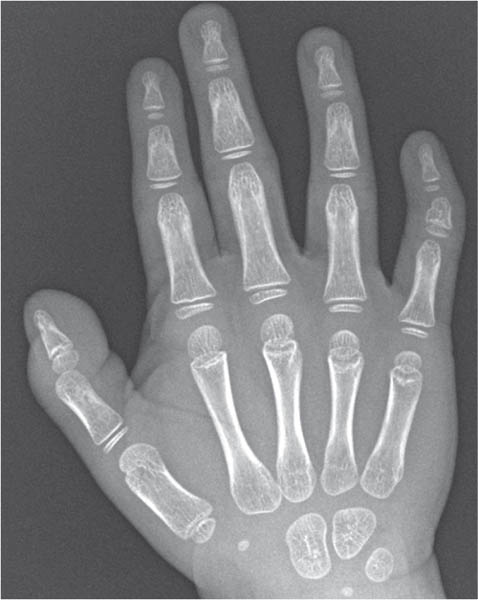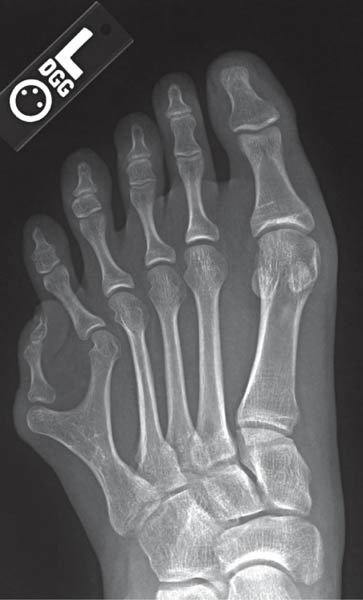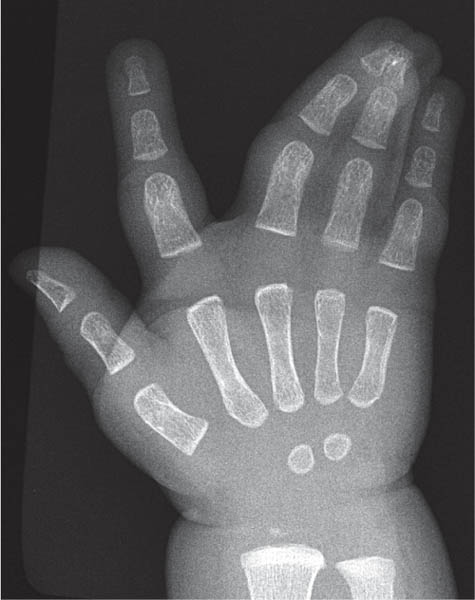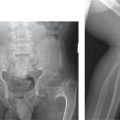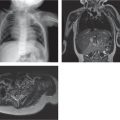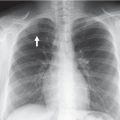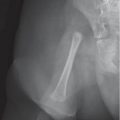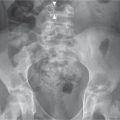Adactyly
Fig. 5.96 |
Absence of metacarpal or metatarsal. |
DD: sporatic, Kniest dysplasia, aplasia cutis congenita, Adams-Oliver syndrome. |
Brachydactyly |
Shortness of the digits. |
Often an isolated finding. Associated with many inherited disorders (see Table 5.59 ). |
Camptodactyly |
Flexion deformity of one or more fingers or toes. |
Inherited as an autosomal dominant trait with variable penetrance. Seventy percent are bilateral. Generally affects the interphalangeal joints, mainly the little finger. Although most often an isolated anomaly, it may be occasionally seen with congenital disorders. |
Clinodactyly
Fig. 5.97 |
Radial bowing of the little finger. |
Most often a sporadic incidental finding. DD: trisomy 21, Klinefelter, Russell-Silver, Feingold, Robinow, and Cornelia de Lange syndromes. |
Macrodactyly |
Enlarged digit. |
DD: progressive macrodystrophia lipomatosa, vascular malformation, congenital lymphangioma. Associated conditions: neurofibromatosis type I, lipofibromatosis, hemihypertrophy, tumors, macrodactyly simplex congenital, macromelia, proteus syndrome. |
Perodactyly |
Congenitally deformed fingers or toes. |
Hypoglossia-hypodactylia syndrome, Cornelia de Lange syndrome, thalidomide embryopathy, amniotic band syndrome. |
Polydactyly |
Ranges from total duplication to a rudimentary appendage. |
Most commonly affects the little finger or toe. |
Preaxial = radial |
Usually unilateral, mainly duplication of the thumb. Total duplication generally the same size on both sides (e.g., entire thumb or just a small appendage). |
Total: Fanconi anemia, thrombocytopenia absent radius syndrome, Holt-Oram, Greig cephalopolysyndactyly, Alpert, Carpenter, Pfeiffer, trichorhinophalangeal (type II), and other syndromes. |
Postaxial = ulnar
Fig. 5.98 |
Mainly left-sided, frequently short metacarpal or phalanx. The carpals are rarely affected. |
Asphyxiating thoracic dysplasia and Ellis-van Creveld, Greig cephalopolysyndactyly, Bardet-Biedl, short rib-polydactyly syndromes type I and II (Saldino-Noonan and Majewski), and other syndromes. |
Symphalangism |
Congenital ankylosis of one or more phalangeal joints. |
Not always recognizable at birth because ossification has not yet occurred. May coincide with carpal and tarsal fusion. DD: hereditary absence of the proximal or distal interphalangeal joints, Apert syndrome, diastrophic dysplasia. |
Syndactyly
Fig. 5.99 |
Incomplete separation of the soft tissues and bones of one or more digits. |
Failure of differentiation. Greig cephalopolysyndactyly syndrome. |
